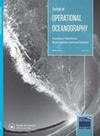Quality of the ERA5 and CFSR winds and their contribution to wave modelling performance in a semi-closed sea
IF 2.4
3区 地球科学
Q4 METEOROLOGY & ATMOSPHERIC SCIENCES
引用次数: 16
Abstract
ABSTRACT This study aims to investigate the quality of ERA5, a recent reanalysis wind product, and its contribution to wave modelling performance in a semi-closed sea, the Black Sea. This investigation includes a comparison of ERA5 surface wind fields with the ones from the CFSR to assess if this latest reanalysis improved the representation of the surface winds. Wind speeds from both reanalyses were validated with measurements at Gloria, the only sea wind measurement station on the Black Sea. Validations were also conducted using altimeter and scatterometer satellite data after which results were later compared against each other. The second aim of this study investigates whether a wave hindcast model forced with the ERA5 wind fields has improved prediction of wave parameters. A SWAN model with default settings was used to compare the results under the same conditions. Performance analyzes of the default SWAN wave estimates with both ERA5 and CFSR winds were conducted using three offshore buoy measurements and altimeter data of satellites over the Black Sea. Results show that ERA5 winds are more biased compared to CFSR winds at Gloria location. Both CFSR and ERA5 underestimate wind speeds. ERA5 performs better than the CFSR in lower wind speeds and worse in higher wind speeds. However, ERA5 winds have less bias and are more scattered than the CFSR winds against the satellite data. SWAN driven by CFSR winds performs better than the one driven by ERA5 winds against both buoy and satellite data.半封闭海中ERA5和CFSR风的质量及其对波浪模拟性能的贡献
摘要:本研究旨在研究最近的再分析风产品ERA5的质量及其对半封闭海黑海波浪模拟性能的贡献。这项调查包括将ERA5地面风场与CFSR的风场进行比较,以评估最新的再分析是否改善了地面风的表征。两次再分析的风速都用格洛里亚(Gloria)的测量结果进行了验证,格洛里亚是黑海上唯一的海风测量站。还使用高度计和散射仪卫星数据进行了验证,之后将结果相互比较。本研究的第二个目的是探讨用ERA5风场强迫的波浪后发模式是否改善了波浪参数的预测。使用缺省设置的SWAN模型对相同条件下的结果进行比较。利用三个海上浮标测量数据和黑海上空卫星高度计数据,对ERA5和CFSR风的缺省SWAN波估计进行了性能分析。结果表明,格洛丽亚地区的ERA5风比CFSR风偏大。CFSR和ERA5都低估了风速。ERA5在低风速条件下优于CFSR,在高风速条件下优于CFSR。然而,与CFSR风相比,ERA5风对卫星数据的偏差更小,更分散。CFSR风驱动的SWAN对浮标和卫星数据的性能都优于ERA5风驱动的SWAN。
本文章由计算机程序翻译,如有差异,请以英文原文为准。
求助全文
约1分钟内获得全文
求助全文
来源期刊
CiteScore
7.50
自引率
9.70%
发文量
8
审稿时长
>12 weeks
期刊介绍:
The Journal of Operational Oceanography will publish papers which examine the role of oceanography in contributing to the fields of: Numerical Weather Prediction; Development of Climatologies; Implications of Ocean Change; Ocean and Climate Forecasting; Ocean Observing Technologies; Eutrophication; Climate Assessment; Shoreline Change; Marine and Sea State Prediction; Model Development and Validation; Coastal Flooding; Reducing Public Health Risks; Short-Range Ocean Forecasting; Forces on Structures; Ocean Policy; Protecting and Restoring Ecosystem health; Controlling and Mitigating Natural Hazards; Safe and Efficient Marine Operations

 求助内容:
求助内容: 应助结果提醒方式:
应助结果提醒方式:


